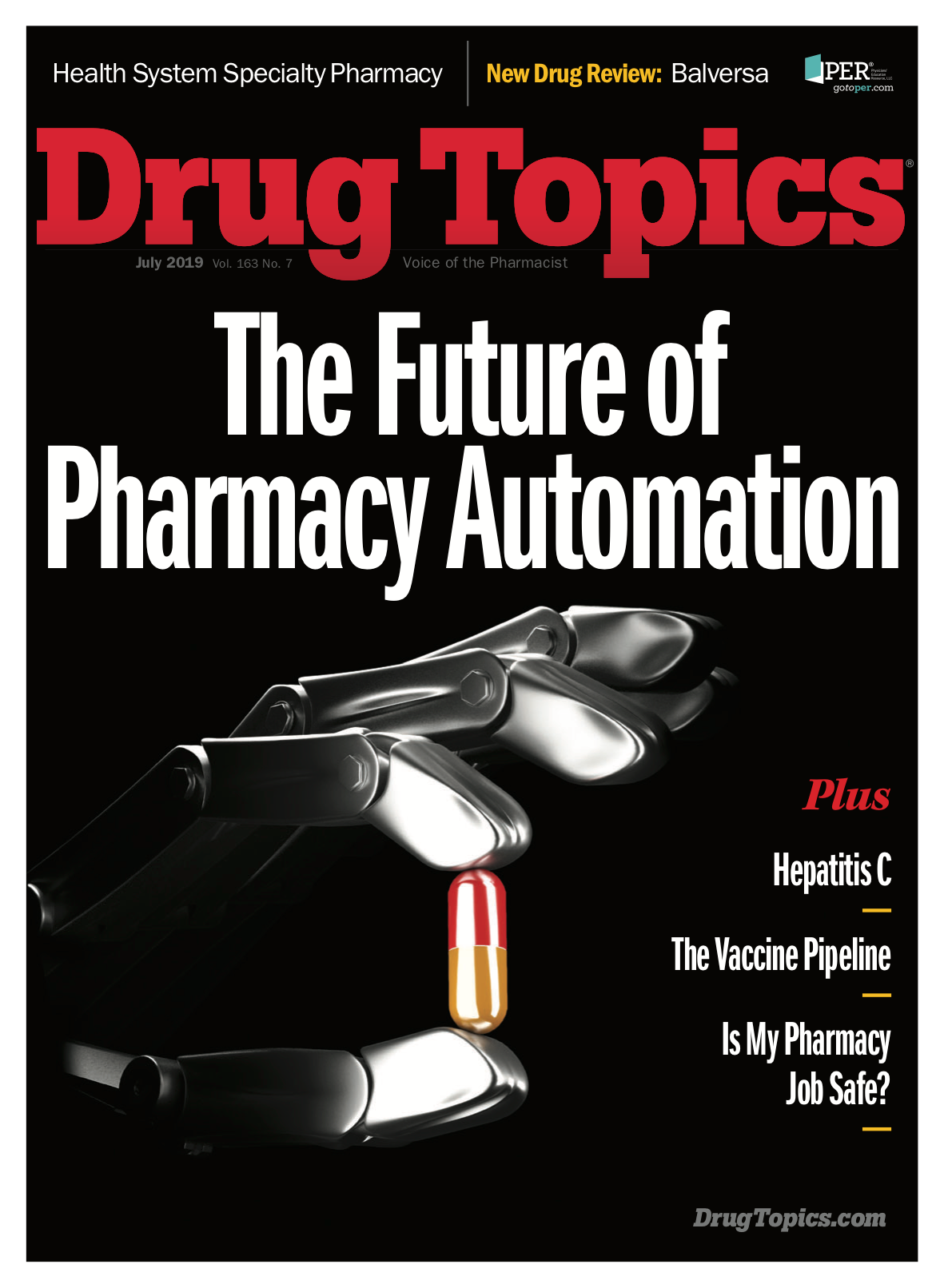The Future of Pharmacy Automation
Affordable dispensing robots are opening new opportunities for community pharmacies.

Pharmacy has a problem: One of the traditional core tasks for most pharmacists is getting medications to patients. Getting the right medication to the right patient at the right time carries the potential for direct interventions that improve patient outcomes. But the mechanics of medication dispensing are mind numbingly tedious, repetitive, and nearly impossible to perform without error.
Pharmacy also has a solution: Automation. Dispensing robots never get bored, never get distracted, and make far fewer mistakes than their human counterparts. And in this era of ever-shrinking prescription margins, dispensing robots free up pharmacists and technicians for more profitable clinical services that require human judgment.
In 2016, Tom Gierwatoski, RPh, installed a ScriptPro dispensing robot in his Platte Valley Pharmacy in Brighton, CO. Automation allowed him to boost prescription volume by 50%, freeing up time to expand compounding and grow nonprescription services such as durable medical equipment and diabetic shoe fitting while halving his dispensing staff.
Trending: 10 Fast Facts About Shingles
“We were able to reallocate staff to things that require more human attention,” Gierwatoski says. “And because the robot cut our average wait time to five minutes, I have more time to talk with patients because I’m not backlogged waiting for prescriptions to get to me.”
Automation has long been a fixture in central fill facilities, large health systems, and other settings that count their daily prescription volume by the thousands. Newer generations of community pharmacy automation have made dispensing robots cost-effective for pharmacies with prescription volumes as low as 150 per day, says Bill Lockwood, executive director of the American Society for Automation in Pharmacy.
“Automation is making pharmacies more efficient, no question about it,” he says. “Increased efficiency is giving pharmacies the opportunity to offer more services and to provide more drug safety.”
One thing robotics isn’t doing is reducing pharmacy employment. Robots are more efficient, more reliable, and less expensive than technicians or pharmacists. Pharmacy owners typically redeploy staff who are no longer needed in dispensing rather than letting them go.
“Dispensing medications will eventually become fully automated using various types of robotics,” predicted Al Babbington, CEO of PrescribeWellness, a Tabula Rasa HealthCare company. “Clinical work-the education, motivations, and support that pharmacists provide to patients to enact behavioral change-will be the new foundational service.”
In his prerobot days, Gierwatoski filled about 200 scripts per day at Platte Valley pharmacy. The operation is located in a hospital, handling hospital outpatient needs and discharge prescriptions as well as serving patients from two dozen physician offices in an attached medical building. About 70% of his prescription volume was, and is, new scripts.
“The volume of new prescriptions meant I had to have two technicians all the time inputting, handling insurance, and everything else associated with new scripts,” he says. “With the robot we are averaging 300 scripts per day and just one technician doing all the inputting. There are plenty of more rewarding and more profitable things we can do versus counting pills on a tray.”
Continue reading on page 2...Robotic Numbers
Dispensing automation comes in a variety of sizes, shapes, capacities, and capabilities, from simple pill counters to robots that spit out a stream of filled, labeled, and capped vials. But robots can’t fill every script.
“Our robots normally cover at least 45% of pharmacy scripts,” says Mike Coughlin, president of ScriptPro. “But we have seen it go as high as 80% or 90%. It depends on the mix of business.”
Gierwatoski says his robot fills about half of his daily prescription volume. Most of the rest are filled using pill counters.
“We might have five scripts a day that we count out by hand” he says.
The key to maximizing robot use is selecting the right drugs for robotic dispensing. The most common method is to track the top 100 to 200 products dispensed at the pharmacy and load the most common into the robot.
Read More: Opinion: The Future of Pharmacy
Local regulation may play a role, too. Gierwatoski points out that Colorado prohibits controlled substances in dispensing robots. So, all of his controlled substance scripts must be filled manually or using pill counters.
Coughlin says the largest ScriptPro robot has 225 cells, which means 225 different drugs or drug dosages can be stored in the system and dispensed. Some customers use multiple robots to keep up with their prescription volume, but the top 200 drugs cover the bulk of products dispensed in most community pharmacies.
Comparing the cost of technician labor to robotic labor is easy. Robots cost about $12 per hour, Coughlin says. Technician salaries average a bit over $18 per hour nationwide. Add in the costs of benefits, hiring, training, and absences and robots look even more financially attractive.
Right Business, Right Robot
Unfortunately, there is no one-size-fits-all automation system. Every manufacturer approaches automation from a different perspective with different types and sizes of practices in mind. Gierwatoski settled on ScriptPro after talking with other pharmacists and spending hours with different automation makers at pharmacy conferences.
It can be tough to choose the right system for a specific pharmacy, says Kurt Proctor, PhD, RPh, senior vice president of strategic initiatives for the NCPA and President of the NCPA Innovation Center. The good news is there are appropriate systems for most pharmacies.
“You can overextend on automation technology and bring in more robotics than your business warrants,” Proctor cautioned. “That’s just a purchasing mistake. But assuming you bring the right automation into your pharmacy, there is no real downside.”
Script volume is only part of the picture when it comes to selecting a dispensing robot. The local labor situation is just as important.
“The robot is doing something that a person would have to do otherwise,” Coughlin says. “If labor is tight, a robot may be the best alternative. We have sites that might not need a robot based on other factors, but have a hard time getting reliable technicians. There is a lot of financial modeling involved in deciding whether or not a robot could be cost-effective and then choosing the right model for your specific practice.”
Trending: Why Technology Upkeep is Up to You
Some automation systems can be customizable with plug-in modules. Surescripts offers an electronic prior authorization plug-in that integrates with electronic health records and helps eliminate forms, faxes and phone calls to healthcare providers. It also offers a price transparency tool that delivers patient-specific drug benefit and cost information at the point of care. Combined with electronic prior authorization, prescribers and pharmacists can make medication decisions with price transparency and complete the prescribing process within the electronic health record, according to the company.
Continue reading on page 3...Support for Automation
NCPA clearly supports pharmacy automation. So does APhA and the Academy of Managed Care Pharmacy. Chain pharmacies and health system pharmacies were early adopters of pharmacy robots.
“We are seeing an increase in the uptake of automation in a lot of areas,” says Samm Anderegg, PharmD, MS, BCPS, a spokesperson for ASHP. “A lot of hospitals are looking into a shared service center, mirroring central fill for a mail order or chain pharmacy. Independents with more than one location are looking at their own central fill operations as well as robots in individual stores.”
Automation is increasing efficiency in all of these settings, Anderegg continued. And despite long standing fears that automation will lead to job losses, pharmacies are using the increased efficiency to redeploy personnel, not cut employment.
When automation moves into the pharmacy, technicians spend less time counting and pouring and more time managing technology. They are also moving into more patient-centered, non-distribution roles that compliment pharmacists in their growing clinical roles.
“Pharmacists want to create and grow new revenue streams to support a clinical business,” Anderegg says. “Automation can support that transition away from fee-for-service distribution models to practice models with the pharmacist as a primary provider or resource for both patients and other providers. The pharmacist sees patients on average of 35 times a year where their primary care doc is seeing them four times a year. That’s a clinical business opportunity.”
New Business Models
Proctor sees pharmacy business models evolving along two parallel tracks. And both rely on automation.
One model is focused on dispensing. The goal is to dispense prescriptions to patients as quickly, accurately, and cheaply as possible. Dispensing robots meet all three goals at the same time.
The other model is focused on care management, more complex patients, and preventive services to keep people out of hospitals, physician offices, emergency rooms, and other higher-cost sites.
That means focusing on a full line of immunizations and vaccines, clinical testing, and other services as allowed by state practice acts. And it means jumping into clinical programs such as the enhanced medication therapy management pilot from CMS management and the CMS chronic care management pilot that brings patients into the pharmacy for scheduled monthly visits.
Trending: The 25 Cities With The Highest Pharmacist Salaries: 2018
Washington and other states are including pharmacists in both public and private payer networks, Anderegg noted. That opens more opportunities to expand clinical services for direct reimbursement, which requires more time to document and bill for services.
Anderegg’s company, DocStation, provides some of those back office solutions, but pharmacies still need more staff hours freed up from counting pills, answering insurance questions, working through PBM logjams, managing inventory, and other dispensing duties to track interventions, outcomes, and reimbursement claims.
“There is plenty of dispensing as part of the care management model, and automation gives you the time to focus on care instead of product,” Proctor says. “The rest of healthcare is spending a ton of money, mostly in nurse call centers, trying to reach people on the phone. The community pharmacist already has that relationship with patients, physicians, social services and already sees patients 35 times a year. That’s when you start to develop a business model that is not solely focused on the dispensing silo, PBM-controlled world.”
